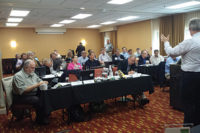For decades, fire sprinklers have proven to be an extraordinarily potent tool for protecting property and life from the potentially devastating effects of fire. With the increased awareness and public concern for building safety, there is a growing need for buildings to be fitted with effective security and safety systems. While fire sprinklers have effectively been used to reduce the loss of life and property from fires for more than 100 years, it is also the case that expanded end-use applications and changing installation environments require ongoing performance assessments and periodic product enhancements to ensure a high level of effectiveness in the future.
As a part of Underwriters Laboratories Inc.'s (UL's) standards development process, UL routinely considers field experience to assess the need for revision of product requirements or installation standards. It was in this context that UL identified opportunities to upgrade the performance requirements for several sprinkler products. In recent years, a number of revisions have been introduced into UL's sprinkler standards to enhance the operating performance characteristics of both wet and dry sprinklers.

Sprinkler Standards and Requirements
On a global basis, there are several standards that include requirements for sprinklers and associated system devices. This article will focus on requirements that are included in sprinkler standards published by UL. Currently, UL publishes three standards for sprinkler products described as follows:
- Standard for Automatic Sprinklers for Fire-Protection Service, UL 199.1
- Standard for Residential Sprinklers for Fire-Protection Service, UL 1626.2
- Standard for Early-Suppression Fast-Response Sprinklers, UL 1767.3
The products covered by these standards are intended to be installed in accordance with the nationally recognized installation standards published by the National Fire Protection Association (NFPA), including the Standards for Installation of Sprinkler Systems, NFPA 134; Installation of Sprinkler Systems in One- and Two-Family Dwellings and Manufactured Homes, NFPA 13D5; and Installation of Sprinkler Systems in Residential Occupancies up to and Including Four Stories in Height, NFPA 13R6. With regard to maintenance, the Standard for Inspection, Testing and Maintenance of Water-Based Fire Protection Systems, NFPA 257, contains comprehensive requirements for assessing the ability of the sprinkler system to operate as intended on an ongoing basis.
The fire sprinkler community is generally aware of the fact that UL's sprinkler standards contain tests to evaluate the capability of these products to distribute water in such a manner that will control or suppress fires. However, many are not aware these standards also include tests to investigate the ability of sprinklers to operate and perform as intended under stressed and adverse field conditions. In fact, each of these standards contains more than 35 different performance tests. The following is a brief description of just a few of the tests that have been in the sprinkler standards for a number of years:
- General corrosion tests that expose samples to salt spray, hydrogen sulfide and carbon dioxide-sulfur dioxide atmospheres.
- Stress corrosion tests for copper alloy and stainless steel components.
- Exposure of samples to 98% relative humidity at 200
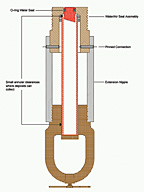 Figure 2. Typical dry sprinkler construction incorporating an O-ring water seal. Note the areas where deposits can collect and inhibit sprinkler operation.
Figure 2. Typical dry sprinkler construction incorporating an O-ring water seal. Note the areas where deposits can collect and inhibit sprinkler operation.Enhancements to Sprinkler Operation Performance
Based upon reports from property owners, sprinkler contractors, authorities having jurisdictions and others, fortified by UL's testing of thousands of sprinkler samples from hundreds of installation locations across the country, two key areas for enhancing sprinkler operation performance were identified. The areas of focus included the release of the water seal assembly and resistance to premature (unwanted) sprinkler operation.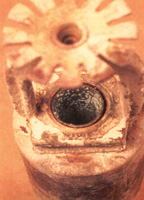 Figure 3. Photograph illustrating the level of deposits created by the new laboratory deposit-forming test. After exposure to the deposit-forming atmosphere, the water seal assembly shall release as intended with an inlet air pressure of seven psig.
Figure 3. Photograph illustrating the level of deposits created by the new laboratory deposit-forming test. After exposure to the deposit-forming atmosphere, the water seal assembly shall release as intended with an inlet air pressure of seven psig.Water Seal Assembly
Until the early 1960s, the prevention of leakage from sprinklers was primarily achieved through the use of a metal-to-metal compression seal arrangement typically employing the use of a copper gasket. Today, a conical spring (commonly referred to as a Belleville spring) with a Teflon film gasket is the most prevalent means used in sprinklers to prevent leakage. A schematic of typical water seal configurations used over the years is provided in Figure 1.Since 1996, UL has conducted operational tests on a large number and type of O-ring sealed sprinklers sampled from field installations. While the operation test results of these sprinkler types varied substantially in the different installation locations (in some locations all samples operated as intended, and in others all samples experienced elevated operating pressures), several O-ring sealed sprinkler constructions have required greater than seven psig to discharge water for more than 30% of the samples tested and greater than 40 psig for 20% of the samples.
Elevated operating pressures were also observed in many dry type sprinkler constructions. Since the 1970s, most dry sprinklers were constructed with O-ring water seals. Accounting for a small percentage of all installed fire sprinklers, dry sprinklers are generally found in locations having harsh environmental conditions, characterized by wide variations in temperature, humidity and corrosive conditions, such as attics, car ports, cold storage structures, parking garages, warehouses and unheated portions of buildings. Testing of more than 1,000 dry sprinklers sent to UL from approximately 130 installation locations throughout the United States revealed that approximately 50% of the sprinklers required a pressure greater than seven psig to discharge water and more than 25% of the samples required a pressure greater than 40 psig to discharge water.
The analyses of wet and dry sprinkler samples received from the field installations have indicated that a broad, but not clearly defined spectrum of materials and chemicals may reside within sprinkler inlets, including various types of oils, surfactants, chemicals associated with water potability and pipe sealing compounds, hard water deposits, sand, dirt, etc. These materials and chemicals may act to accelerate the corrosion process and inhibit the intended movement of sprinkler operating parts.
Based upon these analyses, UL identified four primary factors considered to be contributing to the inhibited sprinkler operation, particularly in O-ring sealed sprinklers:
- The collection of corrosion and other products in the small annular clearances between operating parts.
- Transfer (sticking) of the O-ring material to the mating sealing surface.
- Dezincification.
- Small leakage past the O-ring water seal, causing corrosion and deposits to form on the non-water side of the seal.
To address these concerns, UL adopted several revisions to the UL sprinkler standards. Table 1 summarizes the revisions that were adopted into UL's sprinkler standards related to enhancing the operating performance characteristics of the water seal assembly.
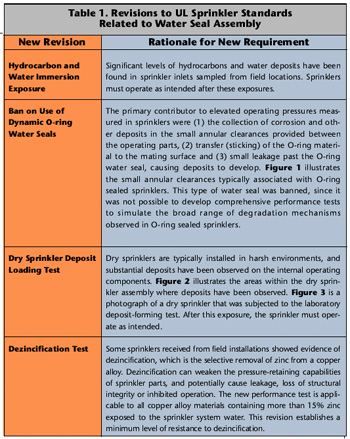
Resistance to Premature Sprinkler Operation
In recent years, UL has received an increased number of field reports of sprinklers discharging water without an apparent cause for the operation. These situations are commonly referred to in the industry as premature sprinkler operation. Based upon available information, it appears that several factors may be contributing to these occurrences. Dry sprinklers installed in freezers and glass bulb sprinklers have been the focus of many of these concerns.With regard to dry sprinklers installed in freezers, ice build-up external and internal to the sprinkler has the potential to apply undesirable stresses to the operating parts. With regard to external ice build-up, it is critical for the hole that accommodates the installation of the dry sprinkler to be properly insulated and sealed. If the annular space between the sprinkler and freezer is not sealed properly, substantial quantities of ice can build-up around the sprinkler due to condensation and hot, moist air entering the freezer. These situations should be readily visible during periodic sprinkler system inspections.
Based upon the same air movement principle, ice may build-up internal to the dry sprinkler if a sprinkler's water seal assembly and extension nipple connection is not completely sealed. To prevent air interchange within the sprinkler and the resulting build-up of ice internally, new requirements have been adopted into UL's sprinkler standards that require this connection to be completely airtight. More detailed information on dry sprinklers installed in freezers is contained in a paper titled, "A Technical Analysis: The Use and
While glass bulbs have been used as heat responsive elements in sprinklers for decades, these bulbs in recent years have been miniaturized to enhance the sensitivity to fire conditions. Considering the general phases of a sprinkler's life, there is ample opportunity for damage or overstressing of glass bulb to occur.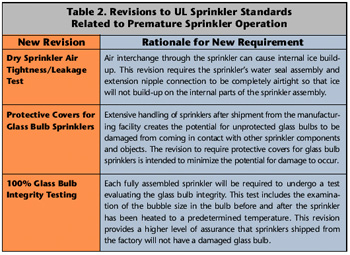
Taking into consideration the scope of the product type requirements contained in UL's sprinkler standards in concert with the potential sources of glass bulb damage, these standards were revised to require 100% glass bulb integrity testing after the sprinkler has been fully assembled and subjected to all the other production testing. This requirement is intended to provide a higher level of assurance that sprinklers are shipped from the factory with a damage-free glass bulb. Also, to minimize the potential for glass bulb damage due to the extensive handling that typically occurs after the sprinkler has left the manufacturing facility, a revision was adopted to require all glass bulb sprinklers be fitted with protective covers.
Table 2 summarizes the revisions to UL sprinkler standards that are intended to reduce premature sprinkler operation occurrences in field installations.
Summary
While this article has focused on actions taken to address concerns related to fire sprinkler operation and opportunities for performance improvement, it is important to keep in perspective the context of this information. It is known that fire sprinklers have established an outstanding record of protecting property and life over many decades.Although concerns have arisen in recent years regarding the operating characteristics of certain sprinklers, the overall effectiveness of sprinkler system protection continues to be at a very high level. In many fire incidents, it has been reported that sprinklers in close proximity to the fire origin have controlled fires and limited damage, even though the sprinkler nearest the fire did not operate as intended. Certainly, these reports are excellent examples of the level of safety incorporated into sprinkler system protection. The ongoing effort to expand the usage of fire sprinklers as a protection tool will make our world a safer place to live.
- The collection of corrosion and other products in the small annular clearances between operating parts.
